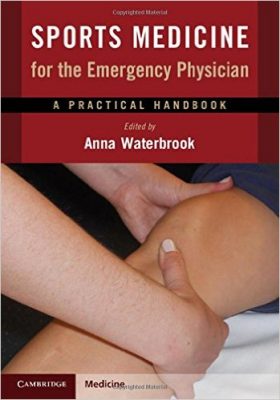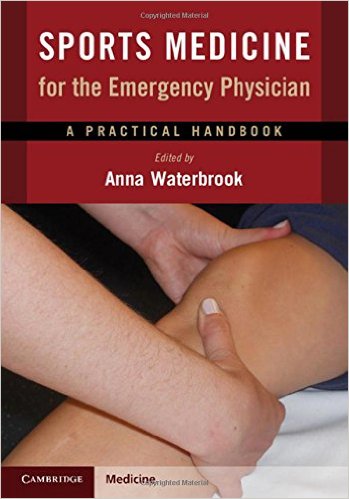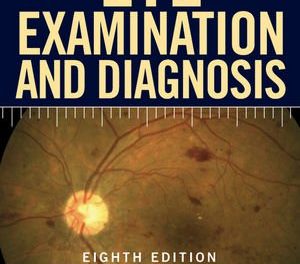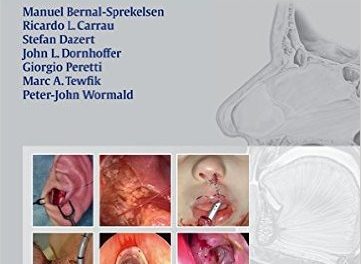 Editor: Anna L. Waterbrook, MD
Editor: Anna L. Waterbrook, MD
Publisher: Cambridge University Press – 427 pages
Book Review by: Nano Khilnani
Musculoskeletal complaints are among the most common, reported in emergency departments, writes the editor Dr. Anna Waterbook in her Introduction. She points out that training in this area is lacking in medical school and residency curricula, and as a result there is a general deficit in musculoskeletal knowledge among medical students, residents, and practitioners.
She writes that emergency medicine (EM) providers “need a few, high-yield musculoskeletal physical exam skills to help them diagnose and rule out life-threatening conditions, while also recognizing common conditions.” This easy-to-use handbook fills that need, as it is written by trained sports EM physicians. It is a guide to the treatment and management of sports injuries for the EM provider working in the emergency department.
Eighteen doctors from all over the United States specializing in emergency medicine and sports medicine, as well as in orthopedics, radiology, and allied fields – many of whom teach at medical centers and universities – authored the 14 chapters of this book. We list them below to provide you an overview of the contents of this book:
Introduction
- Shoulder
- Elbow
- Wrist
- Hand
- Pelvis, Hip, Thigh
- Knee
- Lower Leg and Ankle
- Foot
- Cervical Spine
- Lumbar Spine
- Concussion
- Arrhythmias and Sudden Cardiac Arrest in Athletes
- Exertional Heat Illness
- Basic Principles of Splinting in the Emergency Department
In the chapters, you will be very delighted to find information quickly, which is organized systematically and laid out intelligently for easy access. You will find certain common outline items in every chapter, and once you are familiar with them and the order in which they are presented, you will save time (which is especially precious in the emergency department), and a lot of unnecessary effort. No guesswork is needed to locate what you are looking for.
Below each outline item are the main points that you need to know and be aware of, pertaining to the outline item. These are presented in bullet-point form.
Here below are the common outline items you will find in all chapters:
- Background / Epidemiology
- Anatomical Considerations / Pathophysiology
- Focused History and Physical Exam
- Differential Diagnosis – Emergent and Common Diagnoses
Within the common outline items in each chapter, you will find topics and important points below them that you need to know. For example within the outline item Differential Diagnosis – Emergent and Common Diagnoses in chapter 1, Shoulder, these are the topics:
- Anterior Shoulder Dislocation
- Posterior Shoulder Dislocation
- Inferior Shoulder Dislocation
- Acromioclavicular Joint Injuries
- Sternoclavicular Joint Injury
- Proximal Humerus Fractures
- Scapula Fractures
- Clavicle Fractures
- Rotator Cuff Impingement
- Rotator Cuff Tendinopathy and Tear
- Frozen Shoulder
- Multidirectional Instability
- Shoulder Arthritis
True to its nature as a handbook with outlines and bullet points, you will also find other items provided within each topic. For example within the outline item Diagnosis – Emergent and Common Diagnoses and the topic Anterior Shoulder Dislocation, you will find the following steps to diagnosis of the problem and its treatment:
- General Description
- Mechanism
- Presentation
- Physical Exam
- Essential Diagnostics
- Emergency Department Treatment
- Disposition
- Complications
- Pediatric Considerations
- Pearls and Pitfalls
This book contains a large number of visuals to make your learning and retention easier. All throughout its pages you will find charts, drawings, photos, sketches, magnetic resonance images radiographs, and other types of images. A lot of data is provided in tabular form.
Author and Editor:
Anna L. Waterbrook, MD, FACEP, CAQ-SM graduated from the University of Arizona Medical School in 2004, completed her residency in Emergency Medicine at Maine Medical Center in 2007, and completed her Sports Medicine fellowship at the University of Arizona in 2008.
She is board-certified in both emergency and sports medicine. She is currently practicing both specialties at the University of Arizona, where she is Assistant Professor of Emergency Medicine, Assistant Team Physician for Intercollegiate Athletics, Associate Director for the Sports Medicine Fellowship, and Associate Program Director for the South Campus Emergency Medicine Residency.
She has authored several book chapters and manuscripts in scholarly journals, contributed to the AMSSM Sports Medicine CAQ Study Guide, and given numerous lectures both locally and nationally.
Contributors:
Amanda Akin, DO; Matthew Baird, MD; Brenden J. Balcik, MD; Yvonne C. Chow, MD, CAQ-SM, FACEP; Moira Davenport, MD,CAQ-SM; Jeffrey P. Feden, MD, FACEP; Christopher A. Gee, MD, MPH; Christopher Guyer, MD, CAQ-SM, FACEP; Christopher Hogrefe, MD; William A. Krantz; Allison Lane, MD; Melissa D. Leber, MD; Ross Mathiasen, MD; Aaron J. Monseau, MD, FACEP; Christopher R. Pruitt, MD; Brian L. Springer, MD, FACEP; Timothy W. Thomsen, MD; and Anna L. Waterbrook, MD, FACEP, CAQ-SM.







